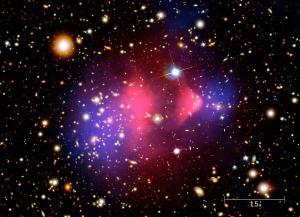
WASHINGTON — Scientists and others were abuzz last week over the long-awaited detection of gravitational waves, but the cosmological community awaits an even more monumental detection: that of the enigmatic substance called dark matter.
The scientific significance of detecting dark matter is “as high [as], or perhaps even higher” than the discovery of gravitational waves, said theoretical cosmologist Carlos Frenk of the Institute for Computational Cosmology in Durham, U.K., during a Feb. 12 symposium at the American Association for the Advancement of Science (AAAS) annual meeting.
Meanwhile, scientists worldwide are using a diverse arsenal of tools and techniques to try to get that first glimpse of the dark universe.
Cosmologists know that dark matter exists because they can observe its gravitational effects on “normal” matter, such as stars and galaxies. Dark matter is five times as abundant as normal matter, and it forms the vast cosmic web in which galaxies are embedded. But because dark matter doesn’t emit light, no one is sure what makes up this mysterious material. Perhaps it’s an exotic breed of fundamental particles, or a whole slew of different particles. Detecting a dark matter particle would help scientists determine its precise properties — a cornerstone in our understanding of the universe.
Past claims of dark matter detection remain hotly contested, Frenk said. So the hunt continues, with researchers operating underground detectors, ground- and space-based observatories, and particle colliders around the globe.
One detection method involves finding the footprints that dark matter particles leave on Earth-bound detectors as the solar system wheels around the center of the galaxy, which is chock-full of dark matter. Such experiments assume that dark matter consists of particles called WIMPs (weakly-interacting massive particles). These particles very rarely interact with ordinary matter. Once in a while, though, a WIMP “bumps” into an atomic nucleus in a dark matter detector, leaving a tangible trace of its passage.
However, other kinds of particles can leave signatures similar to a WIMP’s when they pass through detectors. Because dark matter particles can penetrate layers of rock that other particles cannot, dark matter hunters try to eliminate false alarms by placing their exquisitely sensitive machinery underground. Barring a few curious results that remain unconfirmed, the search for dark matter using such “direct detection” has been “unlucky,” said Elisabetta Barberio of the Center of Excellence for Particle Physics at the Terascale in Parkville, Australia, who also spoke at the symposium.
Meanwhile, astrophysicists keep their eyes peeled for a “glow” produced indirectly by dark matter. Although dark matter does not emit light, dark matter particles can collide and annihilate each other, producing other high-energy particles like positrons and gamma rays. Thus, if telescopes detect an excess of gamma rays in a patch of the sky, there might be a high concentration of dark matter there. Astrophysicists have some idea where to seek these excesses, since computer simulations of the universe have produced theoretical maps of the cosmic dark matter web.
Several research groups have claimed to see dark-matter-generated gamma rays emanating from the center of the Milky Way. However, these findings might be explained by “ordinary” astronomical objects, such as rapidly spinning stars called pulsars.
The third camp of dark matter seekers is trying to forge dark matter particles in manmade particle colliders. Theoretical physicist JoAnne Hewett of the SLAC National Accelerator Laboratory said at the symposium that this detection method is difficult because there are hundreds of theories to describe dark matter particles. Each theory, she noted, predicts that dark matter production will leave a different signature in particle collision data.
Given the uncertainties associated with each dark matter detection tactic, researchers say any claim of dark matter discovery would need to be confirmed using at least one other method.
Using detectors, telescopes, and accelerators in tandem to confirm a dark matter detection could be slow, making the process a messy and gradual one, not a “Eureka!” moment.
Still, the first confirmed glimpse of dark matter might make even greater waves than the recent discovery of literal ripples in spacetime, Frenk said.
Maria Temming is a senior at Elon University studying physics and creative writing. Her work has appeared in Scientific American and Sky & Telescope, and she writes for the Elon Technology Blog. Reach her at mtemming@elon.edu or visit http://mariatemming.com.

